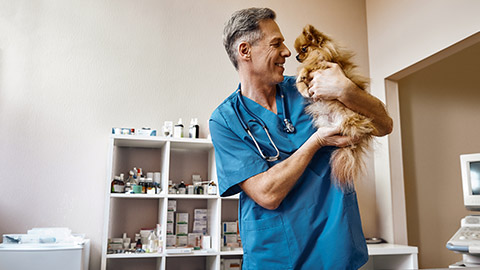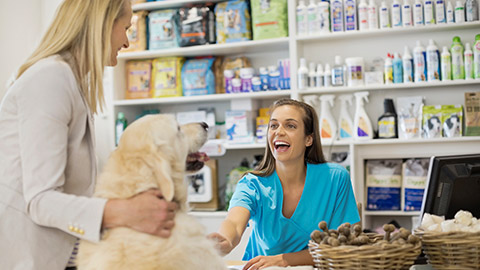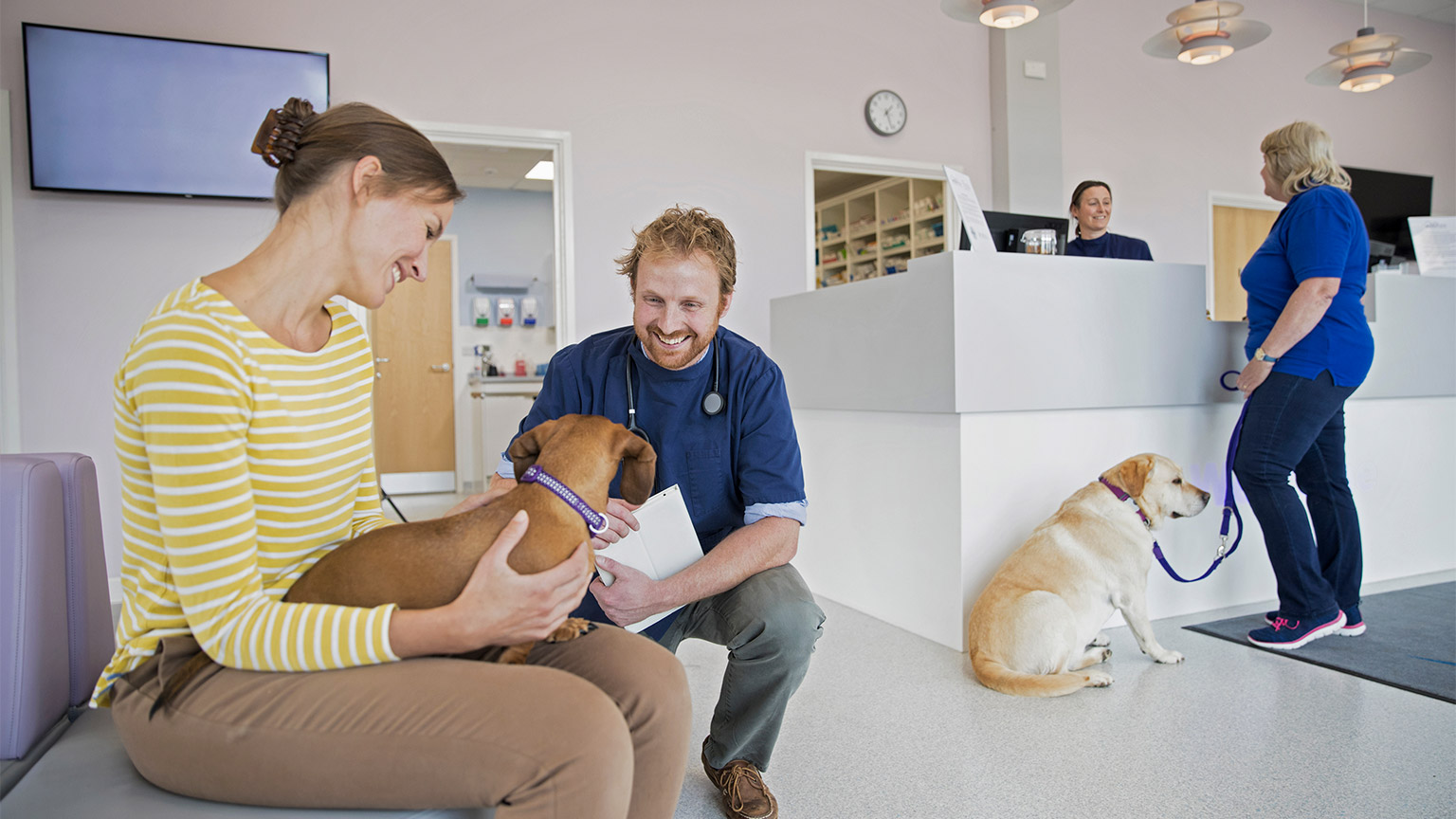Welcome to your next module. This module is clustered. The units of competency we are going to explore in this module is:
- BSBCMM211 Apply communication skills
- ACMGEN310 Provide reception services for an animal care facility
Learning Content
- Learning Content
- Case Studies
- Videos
- Interactive Questions
Assessments
- Quiz
- Short Answer Questions
- SWLA: Structured Workplace Assessment
Benefits of clustering the modules
Clustering learning and assessments is an educational strategy that involves organising related topics and corresponding assessments into cohesive units or modules.
This approach offers several benefits that can significantly enhance student learning and progression through a course:
- Learning Content Assessments
- Focused and Manageable Learning
- Targeted Learning and Assessments
- More organised, engaging and effective learning and assessments
- Supporting student progression
- Making learning manageable

This is Thomas (and Sheba) ...
Thomas works for Noah's Ark Veterinary Clinic as an animal care attendant. He is currently training to become a veterinary nurse and, therefore, has been participating in client consultations and assisting with treatment procedures. The clinic is located in a large town and mainly services families and their domesticated pets, such as dogs, cats and birds; occasionally, they see more exotic pets like snakes or injured native animals. Communication is an important part of Thomas' daily duties and his training regime.
Who do you have to communicate with each day?
Mainly my colleagues and our clients. Our clinic is owned by a husband and wife team, which are both veterinarians and bosses. Two other veterinarians work part-time, and two nurses, myself, another animal care attendant, and our receptionist. We have about twenty patient appointments each day, however there are also some walk-ins and people who visit to make appointments or buy some of our retail products as well as deliveries. We also speak with clients and other stakeholders on the phone fairly regularly.
How does your team collaborate and share information?
We have a regular weekly team meeting every Monday morning. Everyone attends if possible, and we take minutes (notes) of the meeting discussion for the benefit of anyone who couldn't be there. At these meetings, we discuss all the animals that are currently in-house and provide updates on their progress. I am required to provide a report on my allocated animals. The bosses also provide everyone with a summary of how the business is going, marketing initiatives, events and any relevant information that we need to know, such as new equipment or techniques.
The meetings are a good opportunity for me to ask questions about any animal or process that I need clarification on.
Other methods that we use to share information include internal emails and written records/notes on noticeboards. The written notes are particularly useful in the animal housing areas as this is how we communicate feeding, exercise, treatment, and progress information to other staff rostered on different shifts.
What methods of communication do you use to liaise with external stakeholders?
Mainly face-to-face discussions, telephone conversations, and email conversations. Clients visit the clinic and telephone regularly to make appointments, bring their pets in for treatment or enquire about some of our specialised services and procedures. We also communicate via email on treatment reminders and appointment confirmations. Recently, we started using social media to advertise our clinic, and I have been involved with this project as it is an interest of mine. We now run regular ads on Facebook and Instagram. We also have a website that links to the social media pages for potential clients to research. Commonly, the website is used to outline the clinic’s services, bookings, and testimonies from clients, as well as post the monthly newsletter. (The monthly newsletter is also emailed and posted to regular clients)
Our bosses have high expectations for how we communicate, and we need to always be polite and professional, listen attentively, follow their requests and procedures, and use appropriate industry terminology to explain procedures and products to clients.
Sometimes, clients have very specific requests that require a bit of extra research in order to provide them with a solution or answer. In these situations, I sometimes need to let the client know of the possible delay while I obtain the necessary information and then follow up with their query afterwards.

Hi, my name is Kristy, and I work as a receptionist at our local RSPCA facility. My role involves being the first point of contact for anyone who visits or calls our centre. I handle a wide range of tasks, from greeting visitors and answering queries to coordinating with our veterinary and animal care teams. I also manage appointments, assist with the adoption process, and help ensure that all our operations run smoothly. It's a busy role, but I love being able to contribute to the well-being of animals and supporting the team in any way I can.
Who do you have to communicate with each day?
As a receptionist at the RSPCA facility, I communicate daily with various people, including:
- Staff Members: This includes veterinarians, animal care staff, and management to coordinate daily operations and ensure everything runs smoothly.
- Volunteers: I provide them with instructions and updates on their tasks for the day.
- Visitors and Clients: This includes members of the public who visit the facility, adopt animals, or require assistance.
- External Service Providers: These include delivery personnel or maintenance workers.
How does your team collaborate and share information?
Our team collaborates through regular meetings and briefings, both in person and via digital platforms. We use shared online systems to document animal care schedules, adoption status, and other important information. For real-time communication, we rely on instant messaging apps and emails. Collaboration is key, so we frequently update each other on tasks and any urgent issues.
What methods of communication do you use to liaise with external stakeholders?
To liaise with external stakeholders, I primarily use:
- Phone Calls: To directly discuss matters or clarify any urgent concerns.
- Emails: For more formal communication, such as sending reports, schedules, or detailed information.
- Face-to-face meetings: When stakeholders visit the facility or when we need to discuss something in detail.
- Online Forms/Portals: For submitting requests or receiving information from stakeholders, such as suppliers or partner organisations.
What are some of the different communication skills you need in your work?
One of the most important skills I rely on is active listening. When someone comes in or calls, I need to understand their needs and concerns, whether they're looking to adopt an animal, have a question about animal care or are reporting an animal in distress.
Empathy is also vital in my role. Many people who contact the RSPCA are experiencing emotional situations, such as the loss of a pet or the need to surrender an animal. Being able to show understanding and compassion helps build trust and provides comfort during what might be a difficult time for them.
Politeness and professionalism are key, especially when handling multiple tasks like answering phones, scheduling appointments, and assisting visitors simultaneously. It's important to remain calm and courteous, even when things get busy or stressful.
Additionally, I need to be clear and concise in my communication, especially when providing information about our services, explaining procedures, or giving directions. Ensuring that everyone understands what they need to know helps things run smoothly and efficiently.
Finally, teamwork is essential. I often need to coordinate with other staff members, such as veterinarians or animal carers, to ensure that the right information is passed on and that the animals in our care receive the best possible service.
